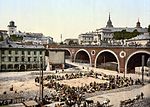2022 Joe Biden speech in Warsaw

On March 26, 2022, roughly a month after Russia launched a full-scale invasion of Ukraine, U.S. president Joe Biden delivered a speech at the Royal Castle in Warsaw, Poland. During the speech, he framed the military struggle in Ukraine as a fight between autocracy and democracy, and confirmed that under NATO's Article 5, the troops of NATO have "a sacred obligation ... to defend each and every inch of NATO territory with the full force of our collective power". He also praised the "brave and stiff Ukrainian resistance" and "the generosity of ... the Polish people", while making it clear that "the Russian people ... are not our enemy". Near the end of his speech, Biden referred to Russian president Vladimir Putin when he said, "For God's sake, this man cannot remain in power." A number of world leaders expressed disapproval over this statement. The Biden administration later stated that these words had not been part of the prepared speech, and that the administration was not proposing a regime change. This remark overshadowed the rest of Biden's speech. About 11 months later, Biden returned to Warsaw to deliver another speech, in which he reiterated that the current conflict was a fight between democracy and autocracy, and reaffirmed NATO's commitment to Article 5.
Excerpt from the Wikipedia article 2022 Joe Biden speech in Warsaw (License: CC BY-SA 3.0, Authors, Images).2022 Joe Biden speech in Warsaw
Plac Zamkowy, Warsaw Śródmieście
Geographical coordinates (GPS) Address Website Nearby Places Show on map
Geographical coordinates (GPS)
| Latitude | Longitude |
|---|---|
| N 52.2479 ° | E 21.0147 ° |
Address
Zamek Królewski
Plac Zamkowy 4
00-277 Warsaw, Śródmieście
Masovian Voivodeship, Poland
Open on Google Maps










